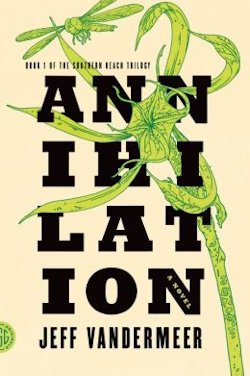A biologist, an anthropologist, a surveyor, and a psychologist venture into Area X.
Sounds like the setup for a joke, doesn’t it? Well halt that thought, because Annihilation is no laughing matter. On the contrary: Jeff VanderMeer’s first new novel since Finch is a nightmarish narrative about the fungus among us which trades in terror and tension rather than simple titters. It’s the award-winning author’s most accessible text yet… though there’s a very real chance the Southern Reach series will leave you with weird dreams for years.
So what the hell is Area X?
The government’s version of events emphasised a localised environmental catastrophe stemming from experimental military research. This story leaked into the public sphere over a period of several months so that, like the proverbial frog in a hot pot, people found the news entering their consciousness gradually as part of the general daily noise of media oversaturation about ongoing ecological devastation. Within a year or two, it had become the province of conspiracy theorists and other fringe elements.
But of course, there’s more to the story.
At bottom, Area X is an anomaly; a treasure trove of the unknown. Our unnamed narrator—the biologist of the aforementioned four—describes “a pristine wilderness devoid of any human life,” but this image, like many of the pictures she posits, is imperfect. After all, the mysterious Southern Reach has been overseeing trips into this treacherous territory for several decades. Annihilation, in fact, follows the fortunes of the twelfth such expedition to date… or so the agency tells its members.
They are women to a one, and they are represented throughout by their respective roles. “A name was a dangerous luxury here. Sacrifices didn’t need names,” and that is exactly what they are—that is how some of them even see themselves—thus they are not people but purposes. Their mission: to map Area X. To explore and more in service of the Southern Reach’s knowledge of the anomaly, though the agency may know more than it’s willing to admit.

Despite VanderMeer’s insistence on distance, Annihilation’s characters are counter-intuitively credible, and to a certain extent sympathetic. The psychologist and the surveyor make quite an impression given their supporting roles: the former fundamentally fails as the team’s would-be leader, resulting in some marvellously barbed arguments, and though the latter is made of tougher stuff, it’s a frustration to her that the military training she brings to the table may not save her.
The biologist is still more deftly developed. As a character she’s smart, but hardly charismatic; introverted, yes, yet in love with life—especially the lives of the creatures she’s devoted her career and indeed her free time to over the years. It follows, unfortunately, that her own life leaves a deal to be desired. Her husband was a member of the ill-fated eleventh expedition, but the biologist hasn’t come to Area X for him; for closure or some such floaty notion. She’s here for her own reasons.
Some of these become clear over the course of the story—others linger longer, largely because the biologist only gives us glimpses. When she does deign to deploy her history it’s frequently a means of making up for her routinely unreliable nature as a narrator. A strange way to say sorry, but I had little difficulty accepting the biologist’s apologies: in VanderMeer’s hands her questionable perspective proves immensely immersive.
As does Annihilation’s narrative. It’s a short novel, sure, but every word has a purpose; every passage a pay-off. I’m hesitant to give much more of the game away, so suffice it to say there’s an abundance of the fantastic fungus that VanderMeer has explored before, a commingling of cosmic horror a la Laird Barron, and the dreadful descent that bookends the text—in which the members of the twelfth expedition to Area Area X investigate an impossible corridor of sorts—is like the best bits of House of Leaves with lashings of alarming lichen.
I thought again of the silhoutte of the lighthouse, as I had seen it during the late afternoon of our first day at base camp. We assumed that the structure in question was a lighthouse because the map showed a lighthouse at that location and because everyone immediately recognised what a lighthouse should look like. In fact, the surveyor and anthropologist had both expressed a kind of relief when they had seen the lighthouse. Its appearance on both the map and in reality reassured them, anchored them. Being familiar with its function further reassured them.
With the tower, we knew none of these things. We could not intuit its full outline. We had no sense of its purpose. And now that we had begun to descend into it, the tower still failed to reveal any hint of these things. The psychologist might recite the measurements of the “top” of the tower, but those numbers meant nothing, had no wider context. Without context, clinging to those numbers was a form of madness.
That’s as may be, but if sanity is knowing what’s at the bottom (or top) of Annihilation’s terrible tower (or tunnel), I think I’d rather be mad.
It’s a matter of measurable relief to me that the rest of the Southern Reach series will be released in 2014. For worshippers of the weird, this promises to be a very good year indeed.
Annihilation is available now from Farrar, Straus & Giroux (US) and Feb 27th from 4th Estate (UK)
Niall Alexander is an extra-curricular English teacher who reads and writes about all things weird and wonderful for The Speculative Scotsman, Strange Horizons, and Tor.com. He’s been seen to tweet, twoo.










